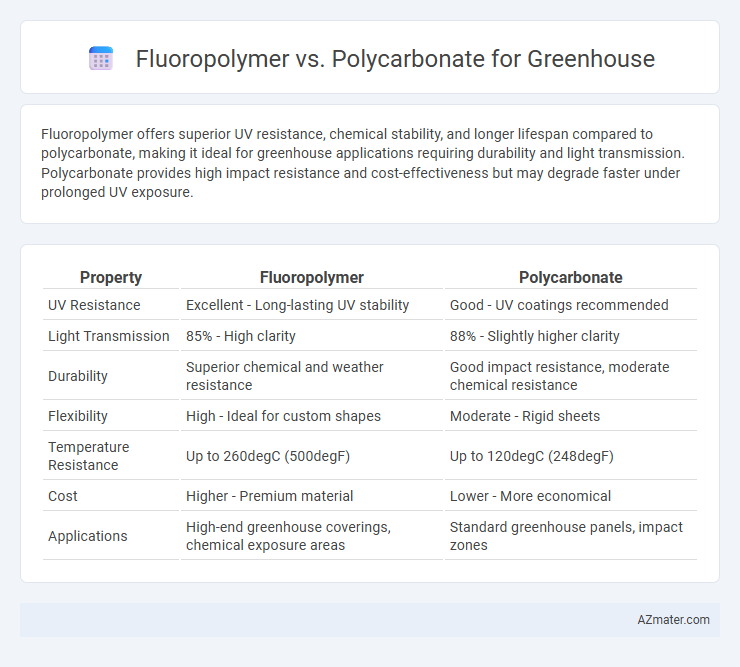Fluoropolymer offers superior UV resistance, chemical stability, and longer lifespan compared to polycarbonate, making it ideal for greenhouse applications requiring durability and light transmission. Polycarbonate provides high impact resistance and cost-effectiveness but may degrade faster under prolonged UV exposure.
Table of Comparison
| Property | Fluoropolymer | Polycarbonate |
|---|---|---|
| UV Resistance | Excellent - Long-lasting UV stability | Good - UV coatings recommended |
| Light Transmission | 85% - High clarity | 88% - Slightly higher clarity |
| Durability | Superior chemical and weather resistance | Good impact resistance, moderate chemical resistance |
| Flexibility | High - Ideal for custom shapes | Moderate - Rigid sheets |
| Temperature Resistance | Up to 260degC (500degF) | Up to 120degC (248degF) |
| Cost | Higher - Premium material | Lower - More economical |
| Applications | High-end greenhouse coverings, chemical exposure areas | Standard greenhouse panels, impact zones |
Introduction to Greenhouse Glazing Materials
Fluoropolymer and polycarbonate are two prominent greenhouse glazing materials offering distinct advantages in light transmission, durability, and thermal insulation. Fluoropolymers provide exceptional UV resistance, chemical stability, and long-term clarity, making them ideal for high-performance, energy-efficient greenhouses. Polycarbonate excels in impact resistance and flexibility, with significant thermal insulation and cost-effectiveness, suitable for various commercial and hobbyist greenhouse applications.
Overview of Fluoropolymer Panels
Fluoropolymer panels are highly valued in greenhouse construction for their exceptional durability, chemical resistance, and superior light transmission compared to polycarbonate. These panels offer excellent UV protection and maintain clarity over time, enhancing plant growth by maximizing photosynthetically active radiation. Their resistance to weathering and thermal stability ensures long-term performance in diverse climatic conditions, making them a premium choice for sustainable greenhouse applications.
Overview of Polycarbonate Panels
Polycarbonate panels are widely used in greenhouses due to their excellent impact resistance, high light transmission, and UV protection, making them durable and efficient in varying climates. They offer thermal insulation properties that help maintain stable temperatures, reducing energy costs. Compared to fluoropolymer films, polycarbonate sheets provide a rigid, long-lasting structure ideal for harsh weather conditions and easy installation.
Light Transmission and UV Stability Comparison
Fluoropolymer films offer superior light transmission rates, often exceeding 90%, while maintaining excellent UV stability with minimal degradation over 20 years, making them ideal for greenhouses requiring consistent sunlight exposure. Polycarbonate panels typically provide 85-90% light transmission but can experience yellowing and UV degradation within 10 years, reducing clarity and structural integrity. The enhanced UV resistance and sustained optical clarity of fluoropolymers ensure longer-lasting performance and optimal plant growth conditions compared to polycarbonate.
Insulation and Energy Efficiency
Fluoropolymer films offer superior insulation and energy efficiency for greenhouses due to their excellent UV resistance and thermal retention properties, reducing heat loss and maintaining stable internal temperatures. Polycarbonate panels provide robust impact resistance with moderate insulation, characterized by a higher R-value that helps in minimizing energy consumption during colder months. Choosing fluoropolymer enhances long-term energy savings through better light transmission and heat management, while polycarbonate balances durability and insulation for versatile climate control.
Durability and Weather Resistance
Fluoropolymer films exhibit exceptional durability and superior weather resistance for greenhouse applications, offering resistance to UV radiation, chemical exposure, and extreme temperatures, which ensures long-term performance without degradation. Polycarbonate panels provide robust impact resistance and high structural strength but may suffer from yellowing and reduced optical clarity over time due to UV exposure unless treated with protective coatings. The choice between fluoropolymer and polycarbonate hinges on balancing long-lasting weather resilience with mechanical toughness to optimize greenhouse lifespan and efficiency.
Maintenance and Longevity
Fluoropolymer greenhouse covers require minimal maintenance due to their superior chemical resistance and UV stability, sustaining clarity and strength for over 20 years. Polycarbonate panels offer good durability and UV protection but often need periodic cleaning and replacement every 10-15 years due to yellowing and brittleness. The long lifespan and low upkeep of fluoropolymer materials make them a cost-effective choice for high-performance greenhouse applications.
Cost Analysis and Budget Considerations
Fluoropolymer greenhouse covering materials typically have higher upfront costs compared to polycarbonate panels but offer superior durability and longer service life, resulting in lower long-term replacement expenses. Polycarbonate sheets provide a more budget-friendly option with easier installation and repair, making them suitable for projects with limited initial funding. Cost analysis should weigh initial investment against maintenance frequency and lifespan, favoring fluoropolymers for high-performance, low-maintenance greenhouses and polycarbonates for cost-sensitive, short-to-medium term applications.
Environmental Impact and Sustainability
Fluoropolymer greenhouse films offer superior durability and UV resistance, significantly reducing the frequency of replacements and waste compared to polycarbonate panels, which have a shorter lifespan and generate more plastic waste over time. Fluoropolymers are typically recyclable and contribute less to thermal waste due to their energy-efficient insulating properties, while polycarbonate production involves higher energy consumption and petrochemical use, impacting overall sustainability. The choice of fluoropolymer supports long-term environmental benefits by minimizing raw material extraction and lowering greenhouse gas emissions throughout the greenhouse lifecycle.
Choosing the Best Material for Your Greenhouse
Fluoropolymer offers superior UV resistance, chemical durability, and long-term translucency, making it ideal for greenhouse glazing that requires maximum light diffusion and weather resilience. Polycarbonate provides excellent impact resistance and affordability but may degrade faster under intense sunlight, necessitating UV coatings for prolonged use. Selecting between fluoropolymer and polycarbonate depends on prioritizing longevity and light transmission against budget constraints and physical durability needs.

Infographic: Fluoropolymer vs Polycarbonate for Greenhouse
 azmater.com
azmater.com